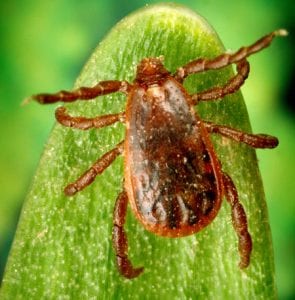Tick bite fever is something many pet owners associate with farm dogs or dogs that take long walks in the country; a disease that is a danger in summer when ticks are plentiful. The reality is that tick bite fever can infect city dogs just as easily and is an ever present danger all year round. It causes disease and death in thousands of dogs in South Africa, which is why we urge pet owners to apply parasite control to their pets all year round.

Ticks are carriers of multiple diseases like ehrlichia (the common name is tick bite fever) and biliary (tick fever / babesia) . Ehrlichia is caused by a blood parasite called Ehrlichia canis that is transmitted when an infected brown dog tick bites your pet. It has two distinct disease forms: acute (early) and chronic (long-standing) form.

Tick bite fever: what to watch out for
In the acute form of ehrlichia the most common signs are fever, loss of appetite, vomiting and diarrhoea. These symptoms usually last about 2-3 days after which some dogs recover.

The tiny dark purple dots at the centre of this blood smear show the ehrlichia parasite
At Cottage Vet we recently admitted a two-year-old Boerbul female who hadn’t eaten for two days and had a high fever. Within minutes of taking blood and putting it onto our microscopic slide, we could very clearly see the ehrlichia parasite in the stain. If ehrlichia progresses to the more chronic form – which is the most commonly seen form – symptoms include spontaneous bleeding (such as nose bleeds or bleeding from the gums), coughing, weight loss, loss of appetite, weakness, enlargement of the lymph nodes, and pale gums. Dogs not treated in the acute form will often progress to the chronic form, which can eventually lead to death.
How is tick bite fever diagnosed?
Diagnosis in the acute form is often difficult without laboratory testing. The parasite can sometimes be seen on a blood smear as in the case with the Boerbul but if not, specific testing may be required to be absolutely sure.
Changes to the dog’s full blood count would aften indicate the possibility of the chronic form, particularly if classic symptoms are also present. Confirmation is again only by specific laboratory tests.
The cornerstone of treatment, a 28-day course of the drug Doxycycline, needs to start as soon as possible. However, severe symptoms such as bleeding and anaemia may require intensive treatments such as hospitalisation with a drip or even a blood transfusion.

How is it prevented?
As with everything, prevention is always better than cure. And it can be simply and safely done all year round. Reputable, continuous long-acting tick and flea protection must be applied, whether you choose chews like Bravecto and Nexguard, spot ons, powders or collars like Seresto. It is not enough to rely simply on shampoos and dips nor on the physical removal of ticks, however often you do it. And don’t think that because you live in a suburb your pets are safe from ticks. Ticks don’t live exclusively on farms; they love a suburban garden or park just as much as farmland.
How to safely remove a tick from your pet
Grasp the tick as closely to the skin as possible with tweezers and pull the tick’s body out slowly and steady. Wear rubber gloves, and clean your pet’s skin with soap and water after removal. Dispose of the tick by putting it into a container with methylated spirits or pure alcohol, or flushing it down the toilet.





